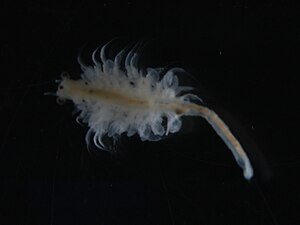Artemia franciscana
This article has been registered in the quality assurance biology for improvement due to formal or content-related deficiencies . This is done in order to bring the quality of the biology articles to an acceptable level. Please help improve this article! Articles that are not significantly improved can be deleted if necessary.
Read the more detailed information in the minimum requirements for biology articles .
| Artemia franciscana | ||||||||||||
|---|---|---|---|---|---|---|---|---|---|---|---|---|

Artemia franciscana |
||||||||||||
| Systematics | ||||||||||||
|
||||||||||||
| Scientific name | ||||||||||||
| Artemia franciscana | ||||||||||||
| Kellogg , 1906 |
Artemia franciscana belongs to the genus Artemia in the order of the gillipers (Anostraca). In the sale it is often incorrectly referred to as Artemia salina , which is much less common in stores.
features
Artemia franciscana grows to about 1–2 cm long and moves forward in the water with its oar feet. The body is colorless, but takes on a red color in an oxygen-poor environment. The red color results from the fact that Artemia franciscana is able to increase the hemoglobin content in the blood if necessary in order to remove more oxygen. In contrast to females, males have two grasping arms at the head end above the eyes with which they hold the female during mating. The females have clearly visible egg sacs.
Occurrence and way of life
Artemia franciscana is native to North America, the Caribbean, the Pacific and Australia; it lives there in highly salty inland waters where there are neither predators nor food competitors. The salinity, pollutant content and purity of these waters vary widely, and Artemia franciscana can only exist there because of its adaptability and ability to change the hemoglobin content of the blood and lay permanent eggs. The permanent eggs can survive for years until they hatch again under suitable conditions. Artemia franciscana filters algae and microorganisms from the water in order to feed.
Reproduction
Artemia franciscana reproduces exclusively sexually, with the male grabbing the female by the head. to mate it. Pairing can take up to several hours. After mating, the Artemia female can either add live nauplii into the water or, if the water quality becomes too poor, lay permanent eggs that can survive longer periods of drought and hatch as soon as the environmental conditions are right again. The development from the nauplie to the finished Artemia takes about one to two weeks.
Importance in the aquarium hobby
Artemia franciscana is bred on a large scale as live or frozen food and is also sold worldwide as live food, whereby it is often incorrectly referred to as brine shrimp ( Artemia salina ). The eggs are also marketed in large quantities, where they are either decapsulated, i.e. freed from their robust shell, offered directly as feed, or as eggs for artemia breeding at home. Many fish keepers breed Artemia themselves because the nauplii are well suited as food for young fish and small fish. But there are also holders who keep Artemia franciscana for their own sake.
literature
Artemia - the primeval shrimp
Web links
http://www.urzeit-krebse.com/de/artemia
http://www.mikes-hobby-blog.de/2014/03/30/artemia-franciscana-zucht-und-haltung/
http: // www .koenigstigers-urzeitkrebse.de / artemia_index.htm
